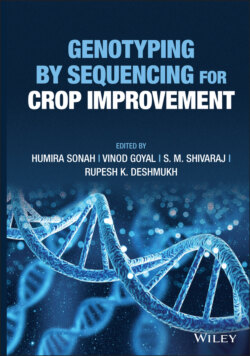Читать книгу Genotyping by Sequencing for Crop Improvement - Группа авторов - Страница 51
Restriction Site‐Associated DNA (RAD‐seq)
ОглавлениеRestriction site‐associated DNA (RAD) is a next‐generation sequencing‐based SNP genotyping method, which allows simultaneous discovery and scoring of thousands of SNP markers in hundreds of individuals. The basic principle behind RAD is the identification of genomic SNPs adjacent to enzyme restriction sites through sequencing. It requires genomic DNA, restriction enzymes, P1 adaptor containing Illumina sequencing forward primer and barcode information, and P2 adaptor containing reverse complement of the reverse amplification primer site. The RAD sequencing library is prepared by digesting genomic DNA of genotypes using restriction enzymes and P1 adaptor is ligated to the compatible ends of the fragments. The adaptor‐ligated fragments are subsequently pooled, randomly sheared, and a specific size fraction is selected following electrophoresis. The DNA fragments are then ligated with P2 adapter and sequenced using Illumina platform (Figure 2.3). The obtained RAD data are analyzed using bioinformatics tools like stack, PyRAD, dDocent, GATK HaplotypeCaller, GATK unifieldGenotyper, samtools mpileup, etc.
One enzyme digestion followed by random sharing causes high DNA loss during RAD sequencing. For organisms without a reference genome, a significant portion of the RAD‐Seq data has been discarded due to sequence read errors and the presence of variable sites. To overcome this problem, slight modification in the RAD sequencing protocol has been carried out. Use of two restriction enzymes instead of a single restriction enzyme and removal of the random sharing steps is adopted. The modified method is renamed as double digest RAD (ddRAD).
